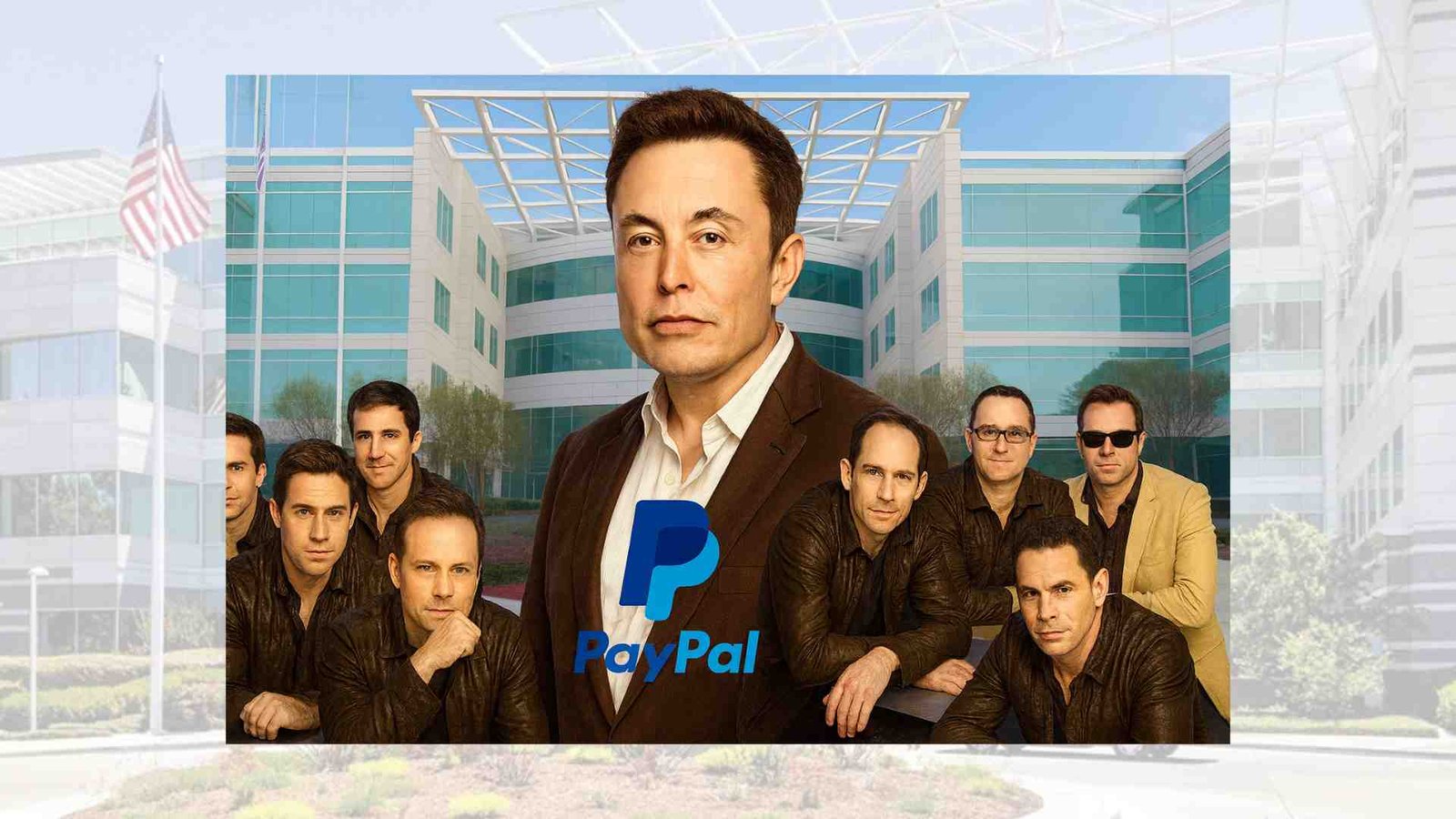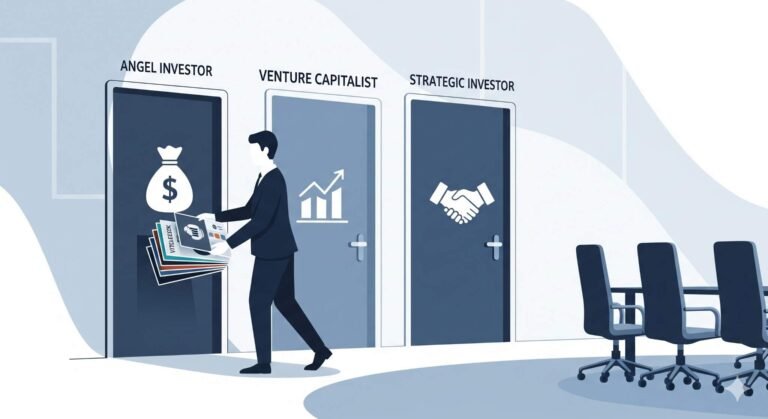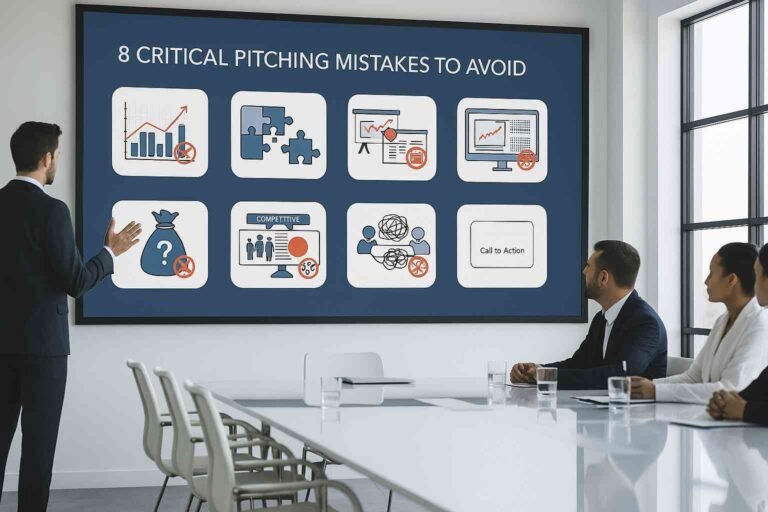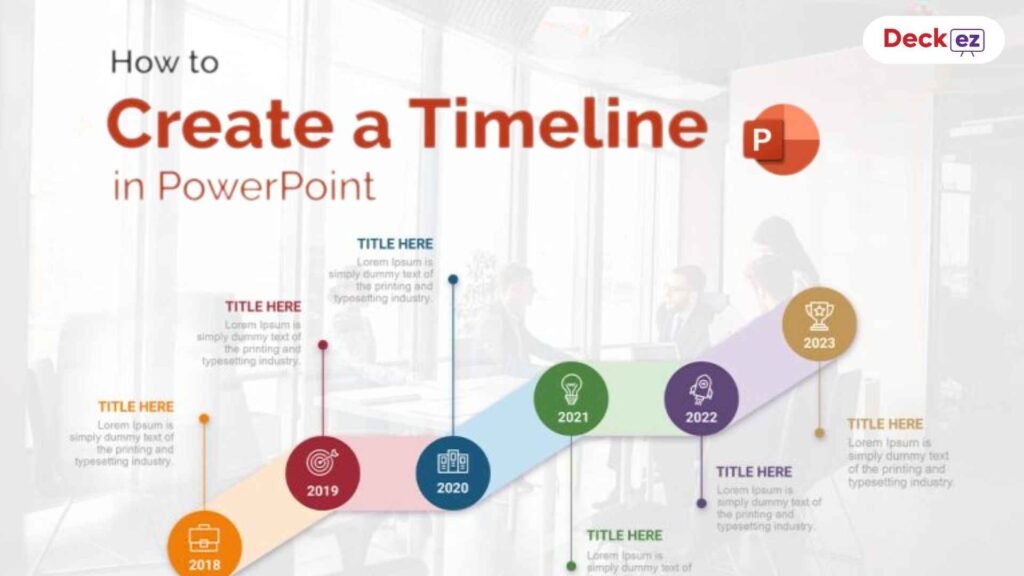PayPal is one of the most successful digital payment companies in the world, but its growth story is not only about technology or timing. A major part of PayPal’s early success came from the way its founders communicated their ideas. They did not overwhelm investors or customers with complex technical explanations. Instead, they used simple language, relatable stories, and clear presentations. This approach helped people understand PayPal instantly, trust it quickly, and adopt it faster than any other digital payment system of that time.
The PayPal founders—Peter Thiel, Max Levchin, Elon Musk (during the X.com phase), Luke Nosek, Ken Howery, and a small team of early contributors—built the company during a time when online payments were confusing, unknown, and even scary for most people. But their presentation style made the idea feel safe, easy, and useful. This blog explains how they communicated their vision and why their simple presentation strategy worked so well.
1. A Clear Beginning: Who the PayPal Founders Were and What They Believed
The story of PayPal begins with two companies: Confinity and X.com. Confinity was founded by Max Levchin, Peter Thiel, and Luke Nosek in 1998. They began with a plan to build security software for handheld devices, but the idea did not take off. Instead of shutting down, they shifted their focus to something different—digital payments.
Their main belief was simple. If money could move as easily as email, millions of people would use it. This belief guided everything they built.
In 1999, Confinity created the first version of PayPal. Around the same time, Elon Musk launched X.com, an online banking startup with big ambition. Musk believed digital payments would replace paper-based transactions one day. When Confinity and X.com merged in March 2000, the combined group of founders aligned around one idea: make online payments simple and safe.
The founders all came from different backgrounds—programming, investment, engineering—but they shared one strong habit. They always explained ideas in the simplest way possible. This habit later shaped their presentations, their business plans, and their growth strategy.
2. How PayPal Started: A Detailed Look at the Early Journey
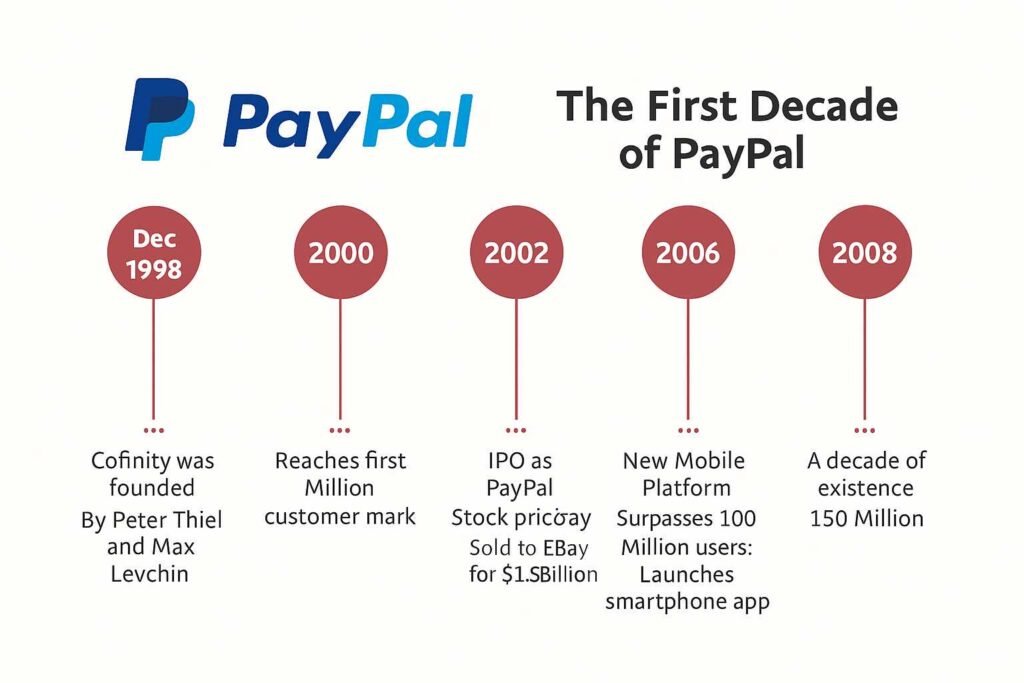
PayPal began at a time when online payments were rare. Most people still used cheques or went to the bank for transfers. PayPal introduced something completely new and easy—sending money online with just an email. This concept was powerful because it removed complicated steps like bank visits, long forms, and delayed transactions.
In the early days, PayPal’s founders faced many challenges. Banks did not understand the idea. Regulators were unsure about online money movement. Even customers were suspicious of entering financial details online. But the founders always responded with calm, clear explanations. They did not use technical terms. They did not show complicated documents. They explained PayPal using simple stories that any person could understand.
Their journey included leadership changes as well. Elon Musk wanted the company to grow aggressively. Peter Thiel focused on stability and structure. In October 2000, Thiel took over as CEO. Under his leadership, the company became more disciplined and prepared a strong plan to go public. The team refined the product, improved security, and polished their message so that investors could understand the value instantly.
By 2002, PayPal had grown so fast that it became the preferred payment option on eBay. The company went public and was later acquired by eBay. This early success was not only because of technology. It was because the founders communicated their ideas clearly and confidently.
If you’re interested in how other major brands handled change, you can also read our breakdown of Nokia’s business failure. It offers useful lessons that connect well with PayPal’s story of adaptation and clarity.
3. PayPal Today: Updated Real-Time Statistics
PayPal remains one of the strongest global financial platforms. Based on recent public reports, the company generated around $29 billion in revenue in FY 2023. This shows stable long-term growth. As of the same year, PayPal reported about 426 million active user accounts, showing how trusted the company still is across the world. These numbers prove that PayPal’s early groundwork created a system that continues to grow even today.
4. How the PayPal Founders Presented Their Idea to Investors

The PayPal founders’ presentation style was very different from most startups at that time. Venture capital presentations in the late 1990s were often filled with long documents, complex charts, and thick financial explanations. But PayPal’s founders went in a different direction.
When they pitched PayPal, they focused on clarity. They began with one question: “Why does sending money still require slow steps when email is instant?” This question made investors think immediately. Instead of discussing technical security algorithms, Max Levchin explained the product by performing simple demos. He would send money from one email to another right in front of the investor. This live demonstration became the strongest part of their pitch.
Peter Thiel handled the business explanation. He did not overwhelm investors with heavy financial models. He explained PayPal’s future using simple language. He compared PayPal to basic everyday experiences, like writing a cheque or paying for something in a store, and showed how PayPal made these experiences easier. Investors appreciated this clarity because they understood the problem and the solution instantly.
Elon Musk added a vision-driven layer to the presentations. He talked about the future of money and how it would eventually become digital. Instead of giving long theoretical explanations, he painted a clear picture of a world where people could send money as easily as sending a message. His strength was storytelling. Investors liked how he connected technology with a clear future outcome.
The founders rarely used complicated slides. Their decks were clean. The titles were short. The visuals were simple. The examples were real. Their presentation did not explain how PayPal worked inside. It explained how PayPal made life easier for the user. That difference helped them win investors fast.
The founders also avoided showing dozens of features. They focused on one core benefit—easy online payments. Investors left the meeting with only one strong message in their mind, and that message was enough to secure funding.
For readers who want to improve their own investor presentations, we also have a simple guide on pitch deck for different types of investors. It explains how to tailor your message, just like the PayPal founders did during their early funding rounds.
5. Why Their Simple Presentation Strategy Worked So Well

The main reason PayPal’s presentation style worked was because the founders understood that people remember stories, not technical diagrams. At that time, online payments were new. Investors did not know what encryption, fraud detection, or digital wallets meant. If the founders tried to explain every detail, they would have lost attention.
Instead, they used real examples. They showed how someone selling on eBay could receive money instantly. They showed how two friends could exchange money without cash. These examples made the idea real and practical. Investors immediately saw the demand. They saw how users would adopt it. They saw how PayPal filled a gap that no one else was addressing.
The founders also kept their language short. Even when they talked about scaling, they did not use big business terms. They simply said that more users would use PayPal because it saved time. Their simple explanation created confidence. Investors felt the product was stable because the message was clear.
This approach also helped PayPal attract millions of users. People could easily explain PayPal to others. A simple idea grows faster because it spreads faster. PayPal grew through word-of-mouth, and that is the strongest proof of how powerful simple communication can be.
6. What Every Reader Can Learn from the PayPal Founders
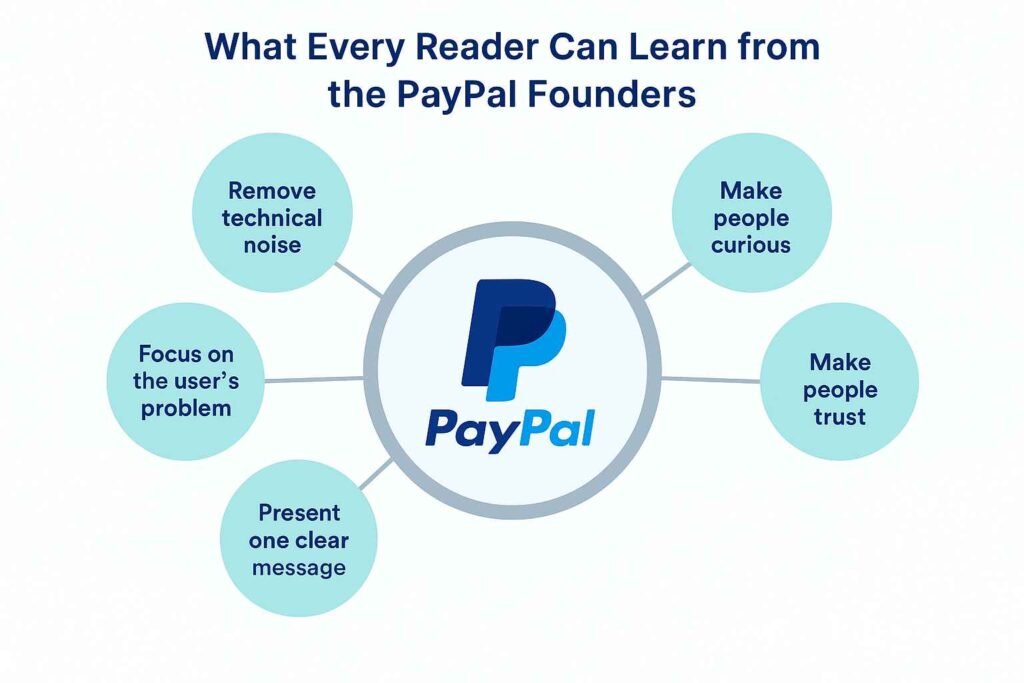
The PayPal founders taught a timeless lesson about communication. A presentation should not confuse people. It should make them curious. It should make them trust you. It should make them understand your message immediately. PayPal’s early success happened because the founders respected the audience. They removed technical noise. They focused on the user’s problem. They presented one clear message instead of many small ones.
If you are a student presenting a project, a founder pitching a startup, or a professional sharing an idea, follow this approach. Keep your slides clean. Use small sentences. Tell a story. Show real examples. Focus on one main idea. When the message is simple, people stay connected. They listen better. They remember your idea. And they share it with others.
7. Final Thoughts: Simplicity Builds Success
The PayPal founders changed the world of digital payments, but their biggest strength was not only technology. It was their ability to explain a complex idea in the simplest possible way. Their clean presentations, their short messages, and their real examples helped investors believe in them. It also helped millions of people trust PayPal.
Their journey proves that ideas don’t win because they are complicated. Ideas win because they are understood. PayPal succeeded because its founders communicated clearly, presented confidently, and always kept things simple. This is a lesson that anyone can use in their personal or professional life. If you want more practical advice on designing clear and simple presentations, you can explore more resources on Deckez, where we simplify complex ideas into clean, easy-to-use templates.
FAQ
1. Who are the main PayPal founders?
PayPal was created through the partnership of two early teams—Confinity and X.com. The key founders include Peter Thiel, Max Levchin, Elon Musk (from the X.com merger), Luke Nosek, and Ken Howery. They each played different roles in shaping the company’s direction and early success.
2. How did the PayPal founders pitch their idea to investors?
The founders used a very simple presentation style. They didn’t fill slides with technical information. Instead, they showed live demos, told short stories, and explained the idea in plain language. Investors could understand PayPal in minutes, which helped them gain trust faster.
3. Why did PayPal’s presentation strategy work so well?
It worked because they focused on what mattered to the listener. They spoke about problems people faced with money transfers, not about complicated software. Their message was easy to repeat, which helped PayPal spread through word-of-mouth.
4. How did PayPal become so successful so fast?
PayPal’s success came from three things: a useful product, simple communication, and strong demand on platforms like eBay. People understood the idea, trusted it quickly, and used it daily.
5. What can I learn from the PayPal founders for my own presentations?
You can follow their approach: use simple sentences, start with a clear problem, show real examples, and keep slides clean. The simpler your message, the easier it is for people to connect with it.

